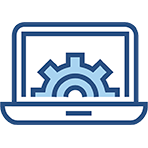Meeting Client Needs
Strategic Automation Services, LLC (SAS) offers a spectrum of control system services, starting with opportunity analysis and following through with the design, implementation and support of the final solution. We provide turn-key services, or supplement your own project team in areas where we deliver the highest value.
Need help converting your Foxboro DCS to an Emerson Delta V?
Not sure if your documentation is up to date? No worries, as we can reverse engineer the Foxboro controls and replicate their functionality in the Delta V system. Strategic Automation Services is a premier Foxboro DCS (IA Series and Evo) DCS systems integrator. We have 20+ years of experience with the Foxboro systems. We use this expertise to accurately convert your Foxboro DCS control strategies and displays to the Delta V environment.
Looking for other DCS or PLC support?
Continue reading to find out more about the wide variety of services that SAS offers.

Opportunity Analysis and Conceptualization
Strategic Automation Services, LLC provides services to define performance improvement opportunities related to process control and management of operation information. Working closely with your staff, we conduct a feasibility study that documents the opportunity, a clearly articulated solution, the estimated costs, expected benefits, and anticipated schedule.
Front end design (FEED) services include, but are not limited to the following areas:
- Process Control – New Systems, Upgrades, Additions, and Improvements
- Collection and Presentation of Operational Information
- Cyber Security Analysis
Examples:
- Control System Upgrade (Panelboard to DCS, old DCS to new DCS)
- Coordinated Compressor Control
- Operator Effectiveness through HMI Improvements
- Tank Farm Management
- In-line Fuels Blending
- Operational Performance Reports
- Integration of Operational Information with Planning and Scheduling Information
- Protecting the Control System from Cyber Attacks
SPECIFICATION AND COSTING OF SOLUTION
When you are ready to specify and cost out the solution to your controls or data management project, let Strategic Automation Services, LLC help. We can specify and cost out the software, hardware, and engineering services needed to deliver the right solution. We offer design services for most major Distributed Control Systems and PLC/HMI suppliers and can develop a custom solution targeted specifically to your project requirements.
Services include:
- Review of solution requirements
- Develop solution specification (hardware, software, services)
- Obtain solution costing (solicit and compile bids for all components of the solution)


Project Management
Good Project Management is critical to the success of any project and is included with every solution we deliver. Our Project Management services are also available to assist your project team when you are working directly with a control system vendor. Our previous work experience with control system vendors provides us a clear understanding of what is required to manage expectations between the vendor and the client.
Examples of how we can assist when you work directly with the controls vendor:
- Initial system design review
- Review of control strategy implementation plan
- Periodic progress review of project implementation tasks
- Pre-FAT of system to ensure the system is ready for the client FAT
- Review of final installation
DESIGN AND IMPLEMENTATION
Once your project is a go, you need someone with leadership, experience, creativity, know-how and discipline to implement the solution. Strategic Automation Services’ staff is known for their ability and commitment to delivering a quality project in a timely manner. Our services are utilized in continuous and batch manufacturing applications across many industries. We provide engineering services for most of the prominent control systems and several operational data management systems.
Control System Design, Integration and Configuration Services:
- Design and implementation of Advanced and Regulatory controls
- New control system design (system specification, historian, operator interface, reporting system, alarm management, etc.)
- Migration of legacy system to new system
- System assembly and configuration (including panel fabrication, system hardware and software)
- Integration with field devices and other systems (PLC, scales, RTU, SIS) to create a unified architecture
- Physical and logical network design
- Network security
- Integrated system testing
- Training for engineering, operations and maintenance
- Documentation of the solution
Systems/Applications Supported:
Distributed Control Systems
- Foxboro IA Series / EVO (premier Foxboro DCS Integrator)
- Emerson Delta-V
- Migration of Moore APAC
Programmable Controllers and HMI
- Rockwell Automation
- GE FANUC
- Siemens
- Schneider
SCADA Systems
- Wonderware
- ClearSCADA
- VTScada
Safety Systems
- Triconex PLC
- ICS Triplex PLC
Historians
- OSIsoft – PI
- AIM*
Reporting Tools & Databases
- Crystal Reports
- MS SQL & SQL Reporting Services
- Oracle





ON-SITE STARTUP, COMMISSIONING, AND TRAINING
Strategic Automation Services, LLC can follow your system to site to ensure that it is installed correctly, and to assist with startup and commissioning activities. Depending on the size and complexity of the system, we can install the system ourselves or advise your own installers.
Many clients are choosing to utilize their purchased control system to provide training for their personnel rather than attending vendor provided classroom training. Utilizing your equipment, we can develop a training program that meets the specific needs of your engineering, operations, and maintenance personnel. If ongoing formalized training is a requirement, then working in partnership with a training simulation company, we can provide a standalone (static or dynamic) training simulator.
Ongoing Support
Over time, business and operational changes often necessitate making modifications to the original systems to maintain peak operational performance.
Our team offers services to modify, enhance, and expand existing systems to address new requirements and standards. We can evaluate your needs, develop a plan, assess the viability of the existing infrastructure, estimate the cost of modifications, implement the changes, train your staff, and update the existing documentation.
We use COTs tools and in-house developed applications to extract the process and system information, which is then used to analyze current performance and develop plans to improve performance.
Common services offered include:
- Alarm Analysis & Rationalization
- Control Loop Performance Analysis
- Implementation of Advanced Control Strategies for Complex Control Situations
- Optimization of Operator Graphics
- Creation of Operational Reports for Supervisors and Management
- Implement Management of Change for DCS
- Document Control System


OPTIMIZATION THROUGH ADVANCED PROCESS CONTROLS
Strategic Automation Services, LLC provides consulting and implementation services to assist you in extracting the maximum value out of your assets. Process Control Optimization can improve:
- Throughput
- Yield
- Product Quality
- Operations Flexibility
- Energy Costs
- Unit Stability
- Safety
- Profitability!!!
Areas of Expertise Include:
- Compressor Control (Anti-surge, Performance, and Load Balance)
- Fired Heater Pass Outlet Temperature Balance Control
- Fired Heater Combustion Control
- Industrial Boiler Combustion Control
- Feedforward Controls with Feedback Trim
Process Control Optimization Examples
Three Element Steam Drum Level Control
The objective of Three Element Steam Drum Level Control is to maintain the water level in steam generation equipment. The application has two operating modes:
- Single element (1-EL) in which the drum level controller manipulates the boiler feed water (BFW) valve directly.
- Three element (3-EL) in which the the drum level controller adjusts a BFW flow controller setpoint with feedforward action based on changes in steam flow rate.
The operator can enable or disable 3-EL mode. When 3-EL mode is enabled, the logic automatically switches to 1-EL when it detects either a bad steam flow or bad BFW flow signal. It also can be configured to switch to 1-EL when the steam rate is too low for proper 3-EL control. The application also includes steam flow compensation based on actual steam table densities, rather than the less accurate (for steam) square root compensation.
Benefits:
- Tighter control of steam drum level, especially during load changes.
- More accurate steam flow indication.
Customer experiences:
- Quicker response to load changes without need for operator intervention – previous controls would not maintain level adequately.
- Unlike previous controls, steam drum level can now be kept in automatic at all times, even during startup and shutdown.
Advanced Level Control
The objective of Advanced Level Control is to maintain a level within a desired control range while making minimal changes to the manipulated variable (i.e., the flow that controls the level). The application achieves this objective via adaptive tuning of the integral portion of the PID algorithm in the level controller.
Normally, integral action causes an excessive adjustment to the manipulated variable which in turn causes a sinusoidal response. The Advanced Level Control algorithm utilizes integral action only when the level is moving away from the desired control range. Integral action is suppressed when the level is making sufficient progress back toward the desired control range. Feedforward action can also be configured in the Advanced Level Control application. Significant load changes can be passed along to the manipulated variable. The feedforward gain is adaptive to make the algorithm more robust.
Benefits:
- More stable operation of downstream equipment, especially in the case of several levels in series.
- Faster and more stable response throughout the unit to load changes, especially in the case of recycle streams.
Customer experiences:
- Several customers could not control the levels in vessels that were piped in series. Load changes would cause oscillation within the system. Advanced Level Control, with feedforward, removed the oscillation and maintained the desired levels such that operator intervention was no longer needed.
- A vessel that received a recycle stream would have large variations in composition due to load changes and slow response of the recycle flow from downstream vessels. Advanced Level Control, with feedforward, sped up the recycle response by adjusting flows throughout the unit simultaneously to match the load change.
DCS-Based Compressor Control
The DCS-Based Compressor Control package includes the following components:
- Anti-surge control for centrifugal compressors
- Performance control.
- Load balancing for multiple compressors.
- Automated compressor start/stop based on load.
The anti-surge control application can operate at 100ms execution frequency in a Foxboro I/A DCS. The surge curve is independent of gas conditions. The special control features include asymmetric control, adaptive tuning, variable control margin, and startup/shutdown ramping. When necessary, feedforward and decoupling action can be configured to improve response to disturbance variables. Performance control adjusts the throughput via suction valve, discharge valve, inlet guide vanes, or motor speed, to meet an operator-entered setpoint for suction pressure, discharge pressure, or net flow delivered. In the case of multiple compressors, the performance controller includes adaptive tuning based on the number of compressors being manipulated. Load balancing adjusts the performance control of multiple compressors to equalize their loads, as measured by relative distance from the control line. The objective is to ensure that all compressors are taking a share of the load. Without load balancing, one or more compressors could be recycling while the others are overloaded. Automated compressor start/stop utilizes a measure of overall load to start or stop a compressor when needed. The next compressor to stop or stop can be set by the operator or automatically determined based on cumulative run time.
Benefits:
- DCS-based control logic is performed in standard DCS control blocks, thus making entire application easy to support.
- Additional control functions can be easily added to logic since compressor controls are in the same DCS as all inputs/outputs.
- Load balancing improves efficiency by eliminating unnecessary recycling
- Automated start/stop reduces cost of operating multiple compressors.
Customer experiences:
- Customers were having trouble with stand-alone compressor control devices that they could not retune to perform properly – several incidents resulted in environmental impacts and process unit trips. A DCS-based compressor control package was implemented. The compressor performed better and could be more easily tuned when necessary.
- Customers were experiencing unit trips when one of two operating compressors shut down unexpectedly and the other compressor was not in a position to take over the entire load. The new compressor control package was implemented. The load balancing controls keep each compressor ready to take over for the other. Adaptive tuning in the performance controller sped up the response when a compressor shut down.
- One customer was having difficulty controlling the plant air header pressure with a collection of old and new air compressors. The compressor control package was implemented for all compressors along with load balancing and automated start/stop. The customer was then able to control the header within 1 psi of setpoint, and large load variations were handled by automatically starting and stopping the less-efficient compressors when necessary.
Heater Pass Outlet Temperature Balance
The Heater Pass Balance application has two control objectives:
- Balance the individual pass outlet temperatures.
- Control the total heater charge.
Both objectives are achieved by adjusting the heater pass flows. The pass balance control alters the distribution of the pass flows without changing the total flow. The total charge control adjusts all of the pass flows up or down without altering the flow distribution. The algorithm utilizes the sensible heat equation to directly calculate the pass flow adjustments necessary to balance the temperatures. The only tuning factors required are a single gain factor to attenuate the control action and the execution frequency. It also includes a ramp function for controlling the total charge.
Benefits:
- Reduction in coke buildup inside the tubes, which increases heat transfer and reduces downtime for decoking.
- Stabilization of unit operation during charge rate changes due to ramp function.
Customer experiences:
- The pass balance algorithm achieved a mean pass temperature difference of 0.5 Deg C – previous attempts to implement other algorithms failed.
- Customer was able to change the crude unit charge rate from 400 MBPD to 200 MBPD and back without losing control of unit – previous attempts were usually aborted because of loss of critical levels throughout unit.
Fired Heater Combustion Control
The Fired Heater Combustion Control application has two control objectives:
- Adjust firing to maintain coil outlet temperature.
- Adjust combustion air to achieve desired excess oxygen target.
The FHCC application includes cross-limiting logic that increases air before fuel on demand increases, and decreases fuel before air on demand decreases. All controllers feature bumpless transfer to cascade mode. Balanced draft controls coordinate FD and ID fan dampers (or speed) to maintain desired firebox pressure. The application includes logic to react to signals from the Burner Management System (BMS) for trip, purge, lightoff, and modulate.
The outlet temperature controller can also be configured for feedforward action that pre-adjusts the firing rate based on changes in charge rate and heater inlet temperature.
Benefits:
- Lower excess air target possible because of cross-limiting control.
- Reduced upsets in downstream equipment because of tighter control over the outlet temperature.
Customer experiences:
- Customer is able to operate at low excess oxygen even during load changes. Previous controls did not have oxygen control.
- Feedforward controls prevented large deviation in heater outlet temperature during charge rate changes. Previous controls would allow significant deviations in temperature.
Industrial Boiler Combustion Control
The Boiler Combustion Control application has two control objectives:
- Adjust firing to maintain steam header pressure.
- Adjust combustion air to achieve desired excess oxygen target.
The BCC application includes cross-limiting logic that increases air before fuel when demand increases, and decreases fuel before air when demand decreases. All controllers feature bumpless transfer to cascade mode. Balanced draft controls coordinate FD and ID fan dampers (or speed) to maintain desired firebox pressure. The application includes logic to react to signals from the Burner Management System (BMS) for trip, purge, lightoff, and modulate. Steam header pressure control includes feedforward action to pre-adjust the firing rate based on changes in steam flows. The pressure controller also features adaptive tuning to adjust for the number of boilers being manipulated.
Benefits:
- Lower excess air target possible because of cross-limiting control.
- Reduced upsets in steam system because of tighter control over the header pressure.
Customer experiences:
- Loss of major steam producer on header resulted in only 5 psi drop in steam pressure with no significant loss of excess oxygen. Previous controls allowed pressure to drop 30 – 40 psi, thus upsetting entire refinery.
- Steam header pressure was controlled to within 1 psi of setpoint under normal operation. Previous controls were allowing deviations of 5 – 10 psi.
- Replacement of combustion controls on three parallel boilers resulted in continuously reliable automatic control of the steam header pressure with no operator intervention required. Previous controls were often run in manual.





